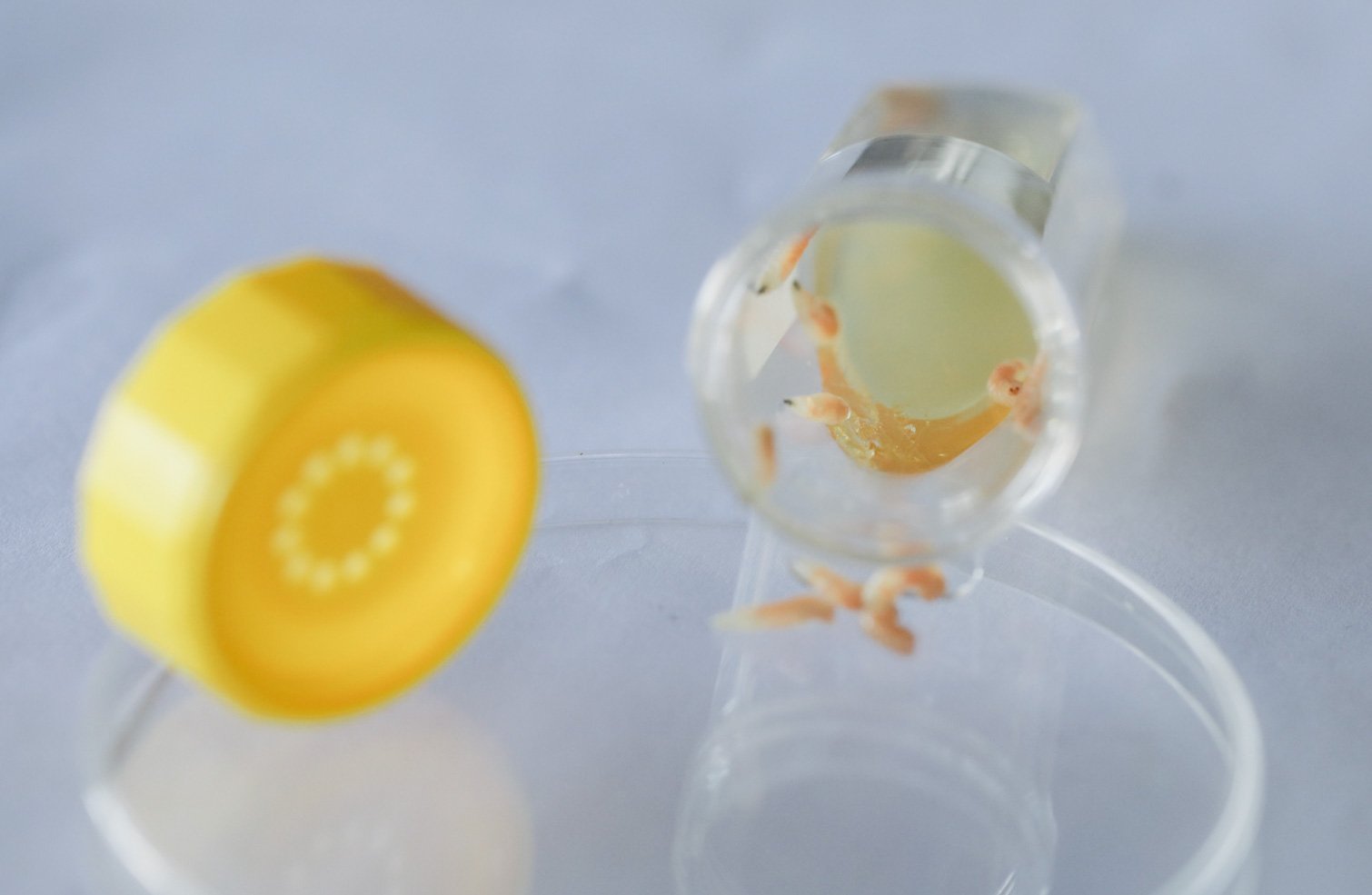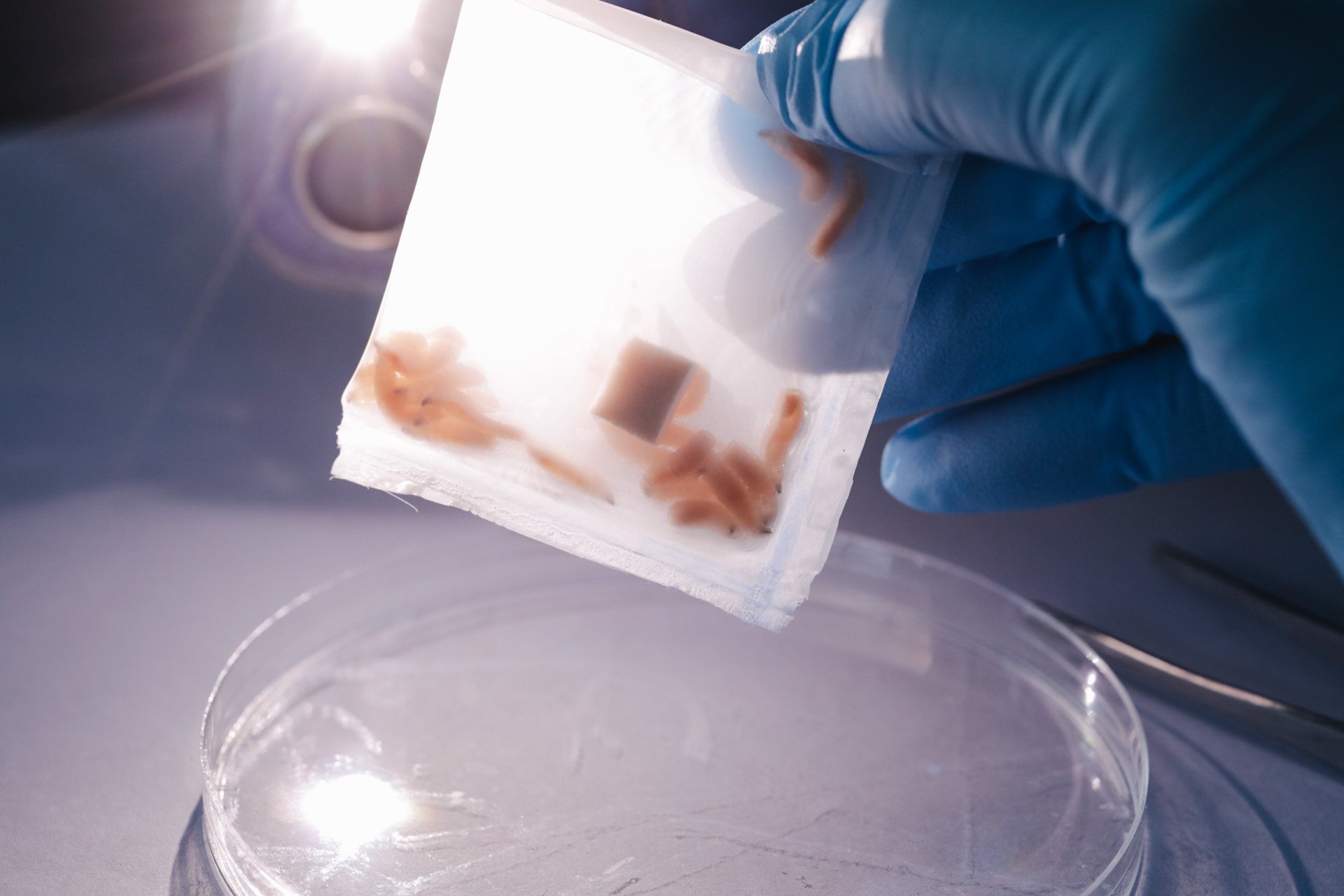
What Is Maggot Therapy &
How Can MEDIFLY Help?
Clean Wounds As Nature Intended
Maggot Therapy (also known as Maggot Debridement Therapy (MDT) or larval therapy), utilises sterile, live larvae of the Lucilia cuprina species, commonly known as greenbottle flies, to eliminate non-viable tissue and bacteria from chronic wounds. The maggots secrete enzymes that break down devitalised tissue, converting it into a liquid of semi-liquid form which they then consume. Assisted by microsurgery techniques, maggots selectively and gently remove unviable tissue and bacteria from the wound.
Introducing MEDIFLY, the only live maggot dressing available in Singapore and Hong Kong
Quick Facts About Maggots in MEDIFLY
Maggots are living creatures requiring oxygen and liquefied food to survive
Maggots have no teeth… only “sucking” parts
Maggots are chemical factories - secreting a powerful mixture of proteolytic enzymes which break down dead tissue, liquidizing it as they move on the surface of the wound
Maggots then ‘suck’ up this liquidized tissue, ingesting it and digesting it
Maggot enzymes only liquefy devitalized tissue including MRSA and leave healthy tissue undisturbed
Maggots also ingest and digest bacteria within the devitalized tissue from the wound, which are also ingested and digested in their gut
Maggots secrete chemicals with inherent antimicrobial activity which help combat infections
Reduced infections decreases inflammation and promotes wound healing
Brief History of Maggot Therapy
Early AD
The utilisation of maggots for wound healing has been well documented across the centuries in different cultures, including the Native Americans, Aboriginal tribes in Australia, and the Chinese.
16th - 18th Century
The beneficial effects of using maggots in wounds were first noticed by Ambrose Paré in 1557. While treating battle wounds in Napoleon’s army, Baron Larrey observed that maggots enhanced granulation formation.
19th Century
The therapeutic use of maggots was documented during the American Civil War. Medical officer Dr. J.F. Zacharias reported, "maggots in a single day would clean a wound much better than any agents we had at our command... I am sure I saved many lives by their use." He recorded a high survival rate in patients he treated with maggots.
1930s
Orthopedic surgeon William Baer refined the MDT technique by using sterile maggots to prevent maggot-induced wound infection. The therapy became increasingly more popular and was widely used for the treatment of chronic or infected wounds across North America and Europe during the 1930s.
1990s
With the rising incidence of antibiotic resistance in the late 1990s, there is renewed interest in maggots and their potential use in chronic wound management.
Present
Cuprina offers Maggot Debridement Therapy through its MEDIFLY product range in Singapore and Hong Kong, with more regions coming soon.
What Can MEDIFLY Do for Chronic Wounds?
1
Removes dead tissue without surgery
2
Disrupts bacteria from forming into biofilms
3
Kills bacteria that cause infections
4
Stops wound breakdown and promotes growth
5
Increases blood supply to the wound
6
Instantaneously reduces wound odour
Is MEDIFLY Right For Me?
Cuprina’s MEDIFLY products are indicated for the debridement of non-healing necrotic skin and soft tissue wounds, including but not limited to:
Diabetic Foot Ulcers
Before MEDIFLY
After MEDIFLY
Pressure Injuries
Before MEDIFLY
After MEDIFLY
Amputation Sites
Before MEDIFLY
After MEDIFLY
Note: The presence of a red color in the wounds suggests an advancing stage of healing, as it signifies the formation of new blood vessels and tissue regeneration, reflecting the body's ongoing efforts to repair and restore the injured area.
Please consult your healthcare professional to assess if MEDIFLY is suitable for you.
MEDIFLY is also effective as a debridement tool on the following wounds:
Venous / Ischemic Ulcers
Malignant Wounds
Burn Wounds
Chronic Osteomyelitis
Traumatic Wounds
MEDIFLY can especially help if the wounds have:
Methicillin-resistant Staphylococcus aureus (MRSA) Infections
Devitalised Tissue
Biofilm
Painful Adhered Slough
Why Should I Choose MEDIFLY?
Patients select MEDIFLY as their chronic wound treatment of choice for many reasons:
(Click on each point below to read more)
-
Maggots clean wounds naturally by eating away dead tissue, cellular fragments and fluids from the wound. They release proteolytic enzymes that help break down damaged tissue into a semi-liquid form, which they can then easily ingest.
Multiple scientific studies have shown that Maggot Therapy is more effective and efficient in removing dead tissue than conventional treatments [Sherman, 2003; Mumcuoglu et al., 1999].
-
Maggots do not digest living human tissue. Maggots heal wounds by feeding on dead tissue and other substances that hinder your wound from healing, such as bacteria. Maggots do all this without damaging viable tissue, meaning they don’t touch the healthy tissue that your body needs to heal.
This selective process is one of the major advantages of maggot therapy, as it spares the healthy tissues necessary for healing.
Some of the science behind it: The secretions of maggots can only break down the extracellular matrix of devitalised tissue, cellular debris and exudate presented in sloughy/necrotic wounds [Cazander et al., 2009]. These enzymes are unable to break down healthy tissue [Nigam et al., 2006].
-
Keeping bacteria under control is crucial for wound healing. Elevated levels of bacteria increase the risk of chronic wound infection and inhibit healing [Armstrong et al., 2023].
Maggots are like tiny clean-up crews. They eat up harmful microbes and help wounds heal faster. Using maggots in healing can reduce infections and keep patients infection-free for longer [Shi et al. 2014].
Studies have shown that maggot secretions can effectively destroy a broad range of bacteria [Jaklic et al., 2008; Daeschlein et al., 2007].
In addition, maggots elevate the pH in wounds, which inhibit bacterial growth [Parnés et al., 2007].
-
Biofilms can cause long-lasting inflammation and stop wounds from healing properly [Davies et al., 2008]. They do this by providing a cozy spot for bacteria to grow, forming communities that are hard to get rid of [Pritchard et al., 2015].
Maggot therapy is a great way to deal with these biofilms. It can both stop them from forming and get rid of them.
The enzymes present in maggot secretions prevent the formation of new biofilm and break down any bacterial biofilm present on the wound bed for ingestion by the maggots. These enzymes also inhibit the formation of new biofilm [Cazander et al., 2008].
-
Multiple studies have proven that wounds like diabetic foot ulcers and pressure ulcers heal faster and better with Maggot Therapy than with other treatments.
For example, a 2014 study discovered that using maggots on diabetic foot ulcers and pressure ulcers led to quicker healing and better growth of healing tissue compared to regular dressings [Sherman, 2014].
This is because Maggot Therapy facilitates cell movement to cover the wound and reduces inflammation in the wound. This sets the stage for the wound to move on to the next healing phase [Horobin et al., 2005].
-
Maggots can help patients avoid imminent amputations.
Maggot Therapy is associated with a threefold lower amputation rate [Sherman, 2014].
It has a 74% success rate in complex diabetic foot wounds that had previously failed all prior conventional wound care [Marineau et al., 2011] and a 90.9% limb salvage rate in a patient population in Singapore [Yeo et al., 2022].
-
Maggots serve as natural wound cleaners. Their consumption of necrotic tissue, which emits unpleasant odors, contributes significantly to odor reduction. In tandem, maggots' consumption of bacteria-rich material indirectly diminishes odor production. Moreover, the enzymatic secretions released during their feeding process work to neutralize odor-causing compounds.
Several clinical studies support these observations, noting a significant decrease in offensive odor accompanying wounds treated with maggots [Mumcuoglu, 2001]
-
Maggot Therapy is relatively safe with minimal side effects aside from slight discomfort and light bleeding [Yeo et al., 2022]. Application of MEDIFLY should take a similar amount of time as traditional wound dressings.
-
Maggot Therapy succeeds about 80% of the time in making wounds better and fully cleaning them in just one treatment. In comparison, conventional treatments only work for about 48% of patients [Gottrup et al., 2011].
-
Studies have demonstrated that Maggot Therapy is the most economical method for removing dead tissue from wounds. This is primarily because of its swiftness and high success rate in effectively removing debris, which leads to a reduced need for amputation, lower infection rates, fewer dressing changes, and reduced requirements for antibiotics and painkillers [Bennett et al., 2013].
What are some precautions of MEDIFLY?
MEDIFLY products should not be used on the following:
Wounds that are located close to an exposed major blood vessel
Patients that are on anticoagulants (e.g. Warfarin)
Wounds located close to exposed organs
Patients that have experienced adverse allergic or inflammatory responses to Maggot Debridement Therapy or its associated wound dressings in the past.
Don’t be alarmed if there is…
Increased exudate
Development of malodour
Discoloured exudate
Increase in pain
Light bleeding
What’s not normal…
Extreme, unbearable pain
Periwound skin irritation
Profuse bleeding
Please consult with a physician or other healthcare professional regarding any medical or health related diagnosis or treatment options.







